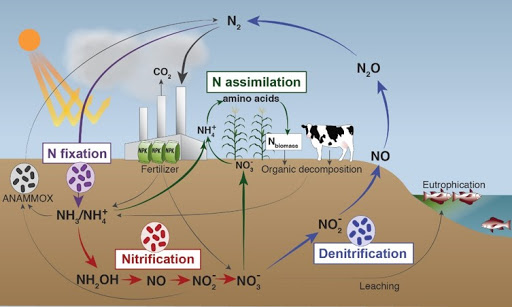We are committed to producing safe, dependable, high-quality natural & organic agronomic inputs.
What is Nitrogen?
Nitrogen is an essential element for all forms of life and it is the most vital nutrient for plant growth and productivity. Nitrogen, which is needed for the synthesis of amino acids and proteins, is the most limiting nutrient for plants.
- Nitrogen makes up approximately 78% of the air we breathe
- This process is called the Nitrogen Cycle
- Nitrogen cannot be absorbed directly by plants
How does the nitrogen cycle work?
Step 1- Nitrogen-Fixation- Special bacteria convert the nitrogen gas (N2 ) to ammonia (NH3) which the plants can use.
Step 2- Nitrification- Nitrification is the process which converts the ammonia into nitrite ions which the plants can take in as nutrients.
Step 3- Ammonification- After all of the living organisms have used the nitrogen, decomposer bacteria convert the nitrogen-rich waste compounds into simpler ones. Step4- Denitrification- Denitrification is the final step in which other bacteria convert the simple nitrogen compounds back into nitrogen gas (N2 ), which is then released back into the atmosphere to begin the cycle again.
The Need for Nitrogen
Plants lacking sufficient nitrogen become yellow and stunted, with smaller than average flowers and fruits. Nitrogen is found naturally in organic matter, manures and other organic fertilizers Nitrogen is a key nutrient for plant growth. Four forms of nitrogen are used as fertilizer: Nitrate, Ammonia, Ammonium & Urea
Urea is broken down by microbes in the soil to become ammonia
Ammonia is broken down into ammonium through mineralization
Ammonium is broken down into nitrite and then nitrate through nitrification
Nitrate is used by plants
Bio-Sustain and Nitrogen Fixation:
Bio-Sustain contains a matrix of Nitrogen fixing beneficial microorganisms & fungi including; Pseudomonas Fluorenscens, Nitrobacter, Nitrosomonas, Achrombacter, Aspergillus, Actinomycetes.
Nitrogen Fixing Microbes: Conversion of atmospheric nitrogen in to ammonia NO3) and nitrate by microorganisms is known as biological nitrogen fixation.
Two groups of microorganisms are involved in the process;
A. Non-symbiotic (free living) Pseudomonas, Nitrobacter, Nitrosomonas, Achromobacter,
B. Symbiotic (Associative), Azospirillum, Actinomycetes
Nitrosomonas bacteria first convert nitrogen gas (ammonia) to nitrite (NO2–) and subsequently
Nitrobacter bacteria convert nitrite to nitrate (NO3–), a plant nutrient.
Achromobacter bacteria produce Nitrogenase an enzyme responsibility for fixing atmospheric nitrogen.
Plants absorb ammonium (NH4+) and nitrate (NO2–) during the assimilation process, after which they are converted into nitrogen-containing organic molecules, such as amino acids and DNA.
Pseudomonas; Denitrification is the reduction of nitrates back into nitrogen gas (N2), completing the nitrogen cycle
Summary
Nitrogen in organic materials must first be decomposed by microorganisms before it can be used by plants. Mineralization is the process by which microbes break down organic matter and release ammonium nitrogen. Ammonium nitrogen, which can be used by plants, does not leach because it has a positive charge so it “sticks” to negatively charged soil particles. If not taken up by plants, ammonium nitrogen will be further degraded by organisms to produce nitrate nitrogen, also available to plants, through the process called nitrification. Nitrate molecules are negatively charged. They will be repelled by negatively charged soil particles, and if not taken up by plants, will move easily with water through soil, potentially resulting in nitrates reaching groundwater.

